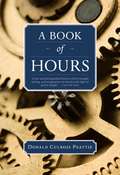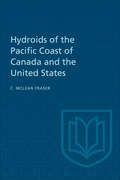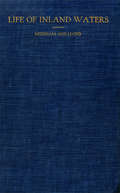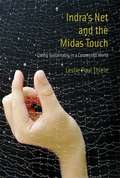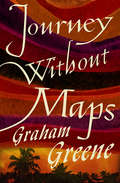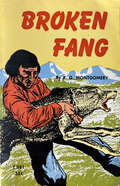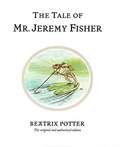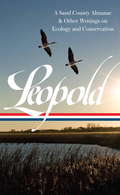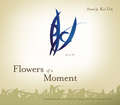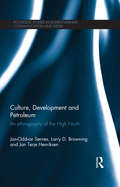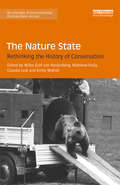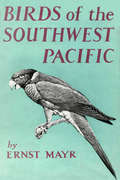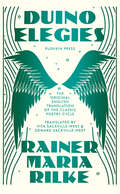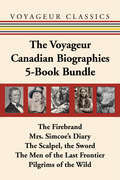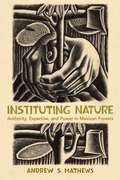- Table View
- List View
Swiss Holiday
by Elizabeth YatesA visit to Switzerland with their adventurous Uncle Tony brings Michael and Meredith new friends and an introduction to the art of mountain climbing.
Tiger Roan
by Glenn BalchThis book relates the adventures of a young roan stallion in the wild, as a bucking horse in the rodeo, and as a saddle horse working with the only man he ever trusts. He meets people who are cruel and care about him only for making money, and one man who is kind and trustworthy, but who must leave him for a time. Will they find each other again?
A Book of Hours
by Donald Culross PeattieA Book of Hours contains 24 essays, one for each hour of the day, that seek to bridge the gap between definitive scientific philosophy and the sheer unadulterated beauty that Donald Culross Peattie envisioned within everyday life. The Boston Transcript referred to this collection as "science, in sheer poetry," and the Chicago Daily Tribune mused that "it leaves one a better man for having read it" and offers "the inevitableness of natural laws and the truth of beauty, if one cares to seek it."
A Book of Hours
by Donald Culross PeattieA Book of Hours contains 24 essays, one for each hour of the day, that seek to bridge the gap between definitive scientific philosophy and the sheer unadulterated beauty that Donald Culross Peattie envisioned within everyday life. The Boston Transcript referred to this collection as "science, in sheer poetry," and the Chicago Daily Tribune mused that "it leaves one a better man for having read it" and offers "the inevitableness of natural laws and the truth of beauty, if one cares to seek it."
Hydroids of the Pacific Coast of Canada and the United States
by Charles McLean FraserHydroids of the Pacific Coast of Canada and the United States is an attempt to give a brief description, with figures, of every hydroid species known to occur along the Pacific Coast of Canada and the United States, together with its distribution within this area. It is intended to provide the Pacific zoologist with a reference, easily understood, to every species of hydroid reported from the coast. Keys to families, genera, and species have been included to facilitate diagnosis. Much of the information presented has already been published, but in widely scattered papers, some of them long out of print. The new contribution is largely in the extensive addition to the distribution records, for which many thousands of specimens have been examined.
Life of Inland Waters: An Elementary Text Book of Fresh-Water Biology For Students
by James G. NeedhamThis work is a textbook of fresh-water life dealing with its forms, its conditions, its fitnesses, its associations, and its economic aspects. The ecologic side of fresh-water biology is emphasized. Due consideration is given to the educational, economic, sanitary, social, civic, and aesthetic aspects of the subject.Limnology in America today is in its infancy. The value of its past achievements is just beginning to be appreciated. The benefits to come from a more intensive study of water life arc just beginning to be disclosed. That there is a widespread interest is already manifest in the large number of biological stations at which limnological work is being done.We recommend this volume as a general introduction to all students and teachers of this subject.
The Terhune Omnibus
by Albert Payson Terhune Max J. HerzbergIn this collection of the work of Albert Pason Terhune, the author shares many of his favorite dog stories, as well, as some of the other stories of animal friends he has written over the years.
Yellow Eyes
by Rutherford MontgomeryYellow Eyes raised and faced about. His amber eyes shone and his ears were laid back. In an instant he struck again and sent the leader of the pack hurtling from the cliff. Against dogs, man, and natural enemies the fierce American cougar fights to keep his rule supreme in the high mountain country of the West.
Birds in the Wilderness: Adventures of an Ornithologist
by George Miksch SuttonTrained as an ornithologist and painter, George M. Sutton recounts a series of adventures with birds in the first decades of the twentieth century. In "Titania and Oberon" he tells the story of raising a pair of baby road-runners. In "The Harris's Sparrow's Eggs" he describes the fierce competition between U.S. and Canadian ornithologists who searched for the nest and eggs of a reclusive bird. In "Kints!" Sutton writes of observing and recording one of the last known nesting pairs of ivory-billed woodpeckers.
Carcajou: King of the North
by Rutherford MontgomeryCARCAJOU was determined to destroy every trap Two Gray Hills set. He bent forward eagerly, one powerful front paw lifted for a lightning stroke. The deadly muzzle of the gun stared blackly upon him." Carcajou, the wolverine — 30 pounds of diabolical cunning and snarling fury — feared by every killer from cougar to grizzly. Indian trappers say he is possessed of an evil spirit. Nature's forces take a hand when Carcajou declares war against Indian trapper Two Gray Hills, and when two deceitful traders plot to steal Two Gray Hills' pet bear.
Indra's Net and the Midas Touch
by Leslie Paul ThieleWe live today in a global web of interdependence, connected technologically, economically, politically, and socially. As a result of these expanding and deepening interdependencies, it has become impossible fully to control--or foretell--the effects of our actions. The world is rife with unintended consequences. Wall Street's reckless investment in toxic assets recently produced massive defaults and a global economic recession. Our attachment to fossil energy is producing a climate default. The first law of human ecology--which declares that we can never do merely one thing--is a truth we ignore at our peril. In Indra's Net and the Midas Touch, Leslie Paul Thiele explores the impact of interdependence and unintended consequences on our pursuit of sustainability. Unfortunately, good intentions provide no antidote to the law of unintended consequences, and proffered cures often prove worse than the disease. Biofuels developed for the purpose of cutting carbon emissions, for example, have had the unintended effect of cutting off food supplies to the needy and cutting down rainforests. The challenge we face is to be ingenious and adaptive in our pursuit of sustainability. But we cannot simply invent our way out of our ecological and economic crisis. Rather, we must fundamentally transform our patterns of thinking and behavior. Thiele offers the intellectual and moral foundations for this transformation, drawing from ecology, ethics, technology, economics, politics, psychology, physics, and metaphysics. Awareness of our interconnectedness, he writes, stimulates creativity and community; it is a profound responsibility and a blessing beyond measure.
Journey Without Maps: Una Aventura Por El Corazón De Liberia (Twentieth Century Classics Ser. #Vol. 7)
by Graham GreeneThe British author embarks on an awe-inspiring trek through 1930s West Africa in “one of the best travel books [of the twentieth] century” (The Independent). When Graham Greene left Liverpool in 1935 for what was then an Africa unmarked by colonization, it was to leave the known transgressions of his own civilization behind for those unknown. First by cargo ship, then by train and truck through Sierra Leone, and finally on foot, Greene embarked on a dangerous and unpredictable 350-mile, four-week trek through Liberia with his cousin, and a handful of servants and bearers, into a world where few had ever seen a white man. For Greene, this odyssey became as much a trip into the primitive interiors of the writer himself as it was a physical journey into a land foreign to his experience. “No one who reads this book will question the value of Greene’s experiment, or emerge unshaken by the penetration, the richness, the integrity of this moving record.” —The Guardian
Broken Fang
by Rutherford MontgomeryThe wolf pack, jaws foaming, burst upon Sioux Charlie with a fury that made the storm seem tame. Back up the trail Charlie's shout was heard by his weary dog Bart. In midstep, the dog halted, lifted his head, and answered his master's cry. Charlie heard that cry with a wild hope springing in his heart — if only Bart could make it in time! Charlie never doubted the dog was coming. In that hour of danger he knew that Bart was true to him.
The History of American Sailing Ships
by Howard I. ChapelleThis is the first complete history published of the development of the various types of sailing vessels and rigs in America from Colonial craft to modern racing and cruising yachts.
The Tale of Mr. Jeremy Fisher
by Beatrix PotterThis is no ordinary fishing trip! "There was a bite almost directly; the float gave a tremendous bobbit!" But this was no minnow, and to find out what it was, you will just have to read this charming story about Mr. Jeremy Fisher (frog) and his friends!
Aldo Leopold: A Sand County Almanac & Other Writings on Conservation and Ecology
by Aldo Leopold Curt MeineSince his death in 1948, Aldo Leopold has been increasingly recognized as one of the indispensable figures of American environmentalism. A pioneering forester, sportsman, wildlife manager, and ecologist, he was also a gifted writer whose farsighted land ethic is proving increasingly relevant in our own time. Now, Leopold's essential contributions to our literature--some hard-to-find or previously unpublished--are gathered in a single volume for the first time. Here is his classic A Sand County Almanac, hailed--with Thoreau's Walden and Carson's Silent Spring--as one of the main literary influences on the modern environmental movement. Published in 1949, it is still astonishing today: a vivid, firsthand, philosophical tour de force. Along with Sand County are more than fifty articles, essays, and lectures exploring the new complexities of ecological science and what we would now call environmental ethics. Leopold's sharp-eyed, often humorous journals are illustrated here for the first time with his original photographs, drawings, and maps. Also unique to this collection is a selection of over 100 letters, most of them never before published, tracing his personal and professional evolution and his efforts to foster in others the love and sense of responsibility he felt for the land.
Flowers of a Moment (Lannan Translations Selection Series)
by Ko Un&“Bodhisattva of Korean poetry, exuberant, demotic, abundant, obsessed with poetic creation . . . Ko Un is a magnificent poet, combination of Buddhist cognoscente, passionate political libertarian, and naturalist historian.&”—Allen Ginsberg"Korea's greatest living Zen poet."—Lawrence Ferlinghetti Flowers of a Moment is a treasure trove of more than 180 brief poems by a major world poet at the apex of his career. A four-time Nobel Prize nominee,Ko Un grew up in Korea during the Japanese occupation. During the Korean War, he was conscripted by the People's Army. In 1952, he became a Buddhist and lived a monastic life for ten years. For his activism confronting South Korea's dictatorial military government, he was imprisoned and tortured. He has published more than one hundred volumes of poetry, essays, fiction, drama, and translations of Chinese poetry. At sunset a wish to become a wolf beneath a fat full moon
Silver Chief: Dog of the North (Famous Dog Stories and Silver Chief #1)
by Jack O'BrienSilver Chief is the son of a Husky whose father was a wolf. After his mother is killed he hates all mankind until a Canadian Mountie shows him kindness.
Culture, Development and Petroleum: An Ethnography of the High North (Routledge Studies in Environmental Communication and Media)
by Jan-Oddvar Sornes Larry Browning Jan Terje HenriksenThe discovery, just forty years ago, of vast oil and gas reserves in the Southwestern part of Norway, and more recently in the Arctic High North region, created an economic titan and posed a vast array of challenges for both the Norwegian government and the residents of this area. How to extract and transport all that oil and gas without despoiling the pristine environment? How to use this wealth in a socially responsible and sustainable way? How to prepare the rural High North citizens—traditionally fishermen and farmers—for a global, high-tech economy? Adopting an original narrative approach to qualitative research, this book tells the stories of 21 individuals either living or having a genuine interest in the High North, from mayors and entrepreneurs to farmers and fishermen. Through these first-hand meetings, it constructs an ethnographic study that reveals how petroleum and development have impacted on the regional economy and culture. This book will be of interest to all stakeholders in the oil and gas industry, and for students and scholars of organization studies, cultural and communication studies, environmental anthropology, natural resource management and sustainable development.
The Nature State: Rethinking the History of Conservation (Routledge Environmental Humanities)
by Wilko Graf Hardenberg Matthew Kelly Claudia Leal Emily WakildThis volume brings together case studies from around the globe (including China, Latin America, the Philippines, Namibia, India and Europe) to explore the history of nature conservation in the twentieth century. It seeks to highlight the state, a central actor in these efforts, which is often taken for granted, and establishes a novel concept – the nature state – as a means for exploring the historical formation of that portion of the state dedicated to managing and protecting nature. Following the Industrial Revolution and post-war exponential increase in human population and consumption, conservation in myriad forms has been one particularly visible way in which the government and its agencies have tried to control, manage or produce nature for reasons other than raw exploitation. Using an interdisciplinary approach and including case studies from across the globe, this edited collection brings together geographers, sociologists, anthropologists and historians in order to examine the degree to which sociopolitical regimes facilitate and shape the emergence and development of nature states. This innovative work marks an early intervention in the tentative turn towards the state in environmental history and will be of great interest to students and practitioners of environmental history, social anthropology and conservation studies.
Birds of the Southwest Pacific
by Ernst MayrThis is the only book in the English language on the birds of the wide area between Fiji, New Caledonia and Micronesia. This practical handbook, by an acknowledged authority, intended primarily for the field student, tells him how to identify and name the birds which he encounters, and what kinds of birds he can expect to find on each island. There is also a condensed summary of the presentknowledge of distribution, geographical variation and habits. Whenever feasible, keys have been supplied to facilitate identification. These keys are simplyand clearly worked out for the beginner who may not know the difference between a curlew and a godwit, or a triller and a graybird.Three magnificent color plates show 39 species which include at least one representation of all of the prominent bird families of the southwest Pacific.A series of black and white drawings show additional species. These pictureswill be particularly valuable to bird students who have never seen awood swallow, a flower pecker, a white-eye or a triller.
Birds of the Southwest Pacific
by Ernst MayrThis is the only book in the English language on the birds of the wide area between Fiji, New Caledonia and Micronesia. This practical handbook, by an acknowledged authority, intended primarily for the field student, tells him how to identify and name the birds which he encounters, and what kinds of birds he can expect to find on each island. There is also a condensed summary of the presentknowledge of distribution, geographical variation and habits. Whenever feasible, keys have been supplied to facilitate identification. These keys are simplyand clearly worked out for the beginner who may not know the difference between a curlew and a godwit, or a triller and a graybird.Three magnificent color plates show 39 species which include at least one representation of all of the prominent bird families of the southwest Pacific.A series of black and white drawings show additional species. These pictureswill be particularly valuable to bird students who have never seen awood swallow, a flower pecker, a white-eye or a triller.
Duino Elegies, Deluxe Edition: The original English translation of Rilke's landmark poetry cycle, by Vita and E dward Sackville-West - reissued for the first time in 90 years
by Rainer Maria RilkeThe first-ever English translation of Rilke&’s landmark poetry cycle, by Vita and Edward Sackville-West – reissued for the first time in 90 yearsIn 1931, Virginia and Leonard Woolf&’s Hogarth Press published a small run of a beautiful edition of Rainer Maria Rilke&’s Duino Elegies, in English translation by the writers Vita and Edward Sackville-West. This marked the English debut of Rilke&’s masterpiece, which would eventually be rendered in English over 20 times, influencing countless poets, musicians and artists across the English-speaking world. Published for the first time in 90 years, the Sackville-Wests&’ translation is both a fascinating historical document and a magnificent blank-verse rendering of Rilke&’s poetry cycle. Featuring a new introduction from critic Lesley Chamberlain, this reissue casts one of European literature&’s great masterpieces in fresh light.
The Voyageur Canadian Biographies 5-Book Bundle: The Firebrand / Mrs. Simcoe's Diary / The Scalpel, the Sword / The Men of the Last Frontier / Pilgrims of the Wild
by Grey Owl James Polk Michael Gnarowski Hugh Eayrs Julie Allan Norman Bethune Allan Susan Ostrovsky Sydney Gordon Mary Quayle Innis Elizabeth Posthuma Simcoe William Kilbourn Ronald StaggVoyageur Classics is a series of special versions of Canadian classics, with added material and new introductory notes. In this bundle we find five biographical and autobiographical titles that shed light on some of Canada’s most important figures at crucial times in the country’s development. William Kilbourn brings to life the rebel Canadian hero William Lyon Mackenzie: able political editor, first mayor of Toronto, and the gadfly of the House of Assembly. The Scalpel, the Sword celebrates the turbulent career of Dr. Norman Bethune, a brilliant surgeon, campaigner for socialized medicine, and communist. Elizabeth Simcoe’s diary, describing Canada from 1791 to 1796, is history written as it was being made, an account instilled with excitement and delight. And finally, two titles by the legendary Grey Owl tell his own astonishing story and advocate for a closeness with and respect for nature. Each of these books is an essential classic of Canadian literature. Includes The Firebrand Mrs. Simcoe’s Diary The Scalpel, the Sword The Men of the Last Frontier Pilgrims of the Wild
Instituting Nature
by Andrew S. MathewsGreater knowledge and transparency are often promoted as the keys to solving a wide array of governance problems. In Instituting Nature, Andrew Mathews describes Mexico's efforts over the past hundred years to manage its forests through forestry science and biodiversity conservation. He shows that transparent knowledge was produced not by official declarations or scientists' expertise but by encounters between the relatively weak forestry bureaucracy and the indigenous people who manage and own the pine forests of Mexico. Mathews charts the performances, collusions, complicities, and evasions that characterize the forestry bureaucracy. He shows that the authority of forestry officials is undermined by the tension between local realities and national policy; officials must juggle sweeping knowledge claims and mundane concealments, ambitious regulations and routine rule breaking. Moving from government offices in Mexico City to forests in the state of Oaxaca, Mathews describes how the science of forestry and bureaucratic practices came to Oaxaca in the 1930s and how local environmental and political contexts set the stage for local resistance. He tells how the indigenous Zapotec people learned the theory and practice of industrial forestry as employees and then put these skills to use when they become the owners and managers of the area's pine forests--eventually incorporating forestry into their successful claims for autonomy from the state. Despite the apparently small scale and local contexts of this balancing act between the power of forestry regulations and the resistance of indigenous communities, Mathews shows that it has large implications--for how we understand the modern state, scientific knowledge, and power and for the global carbon markets for which Mexican forests might become valuable.

